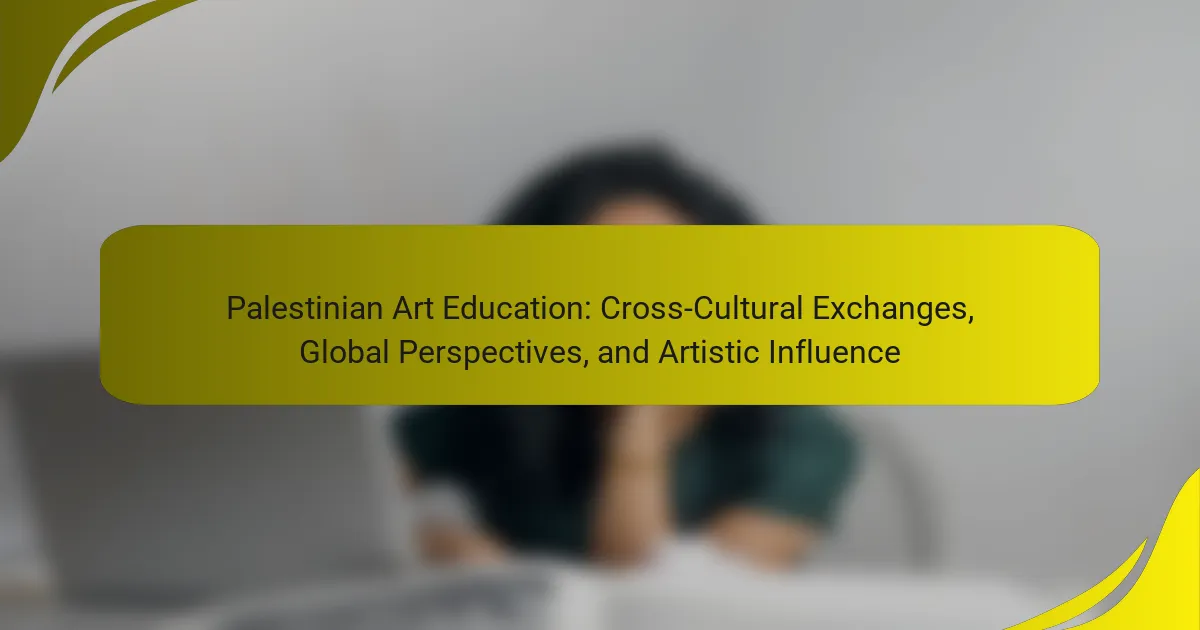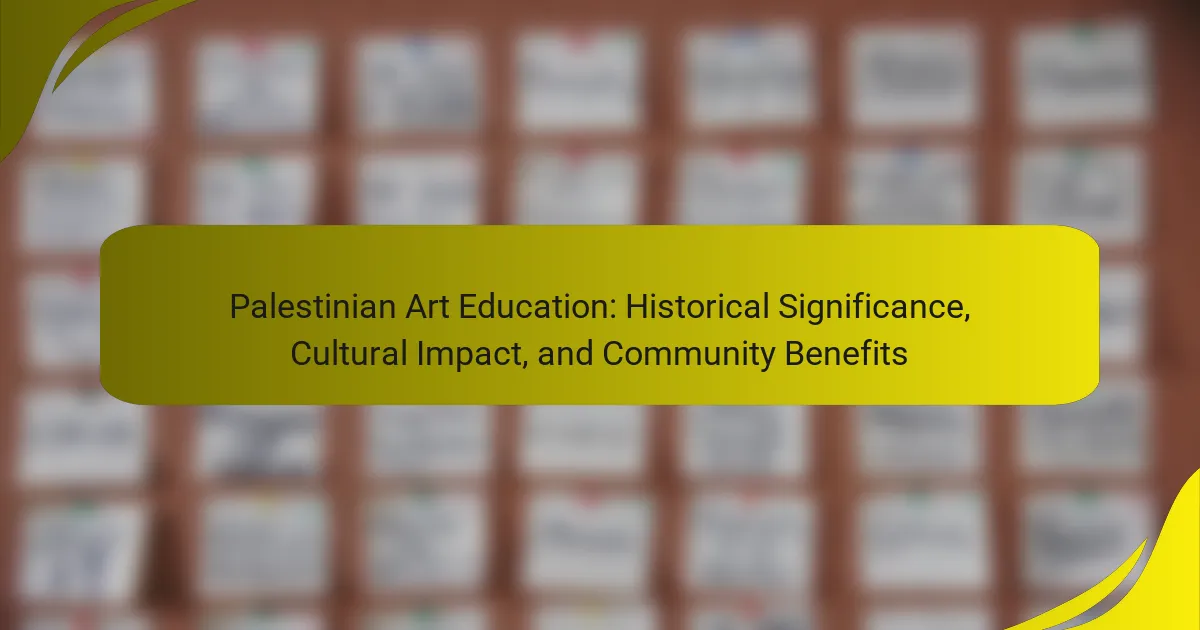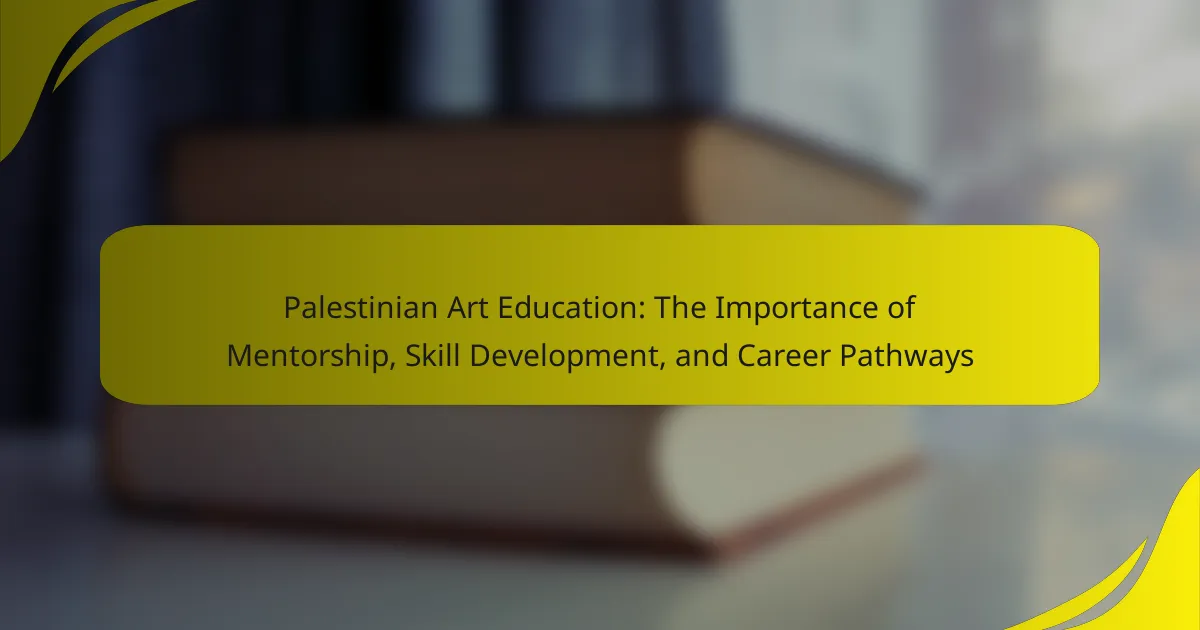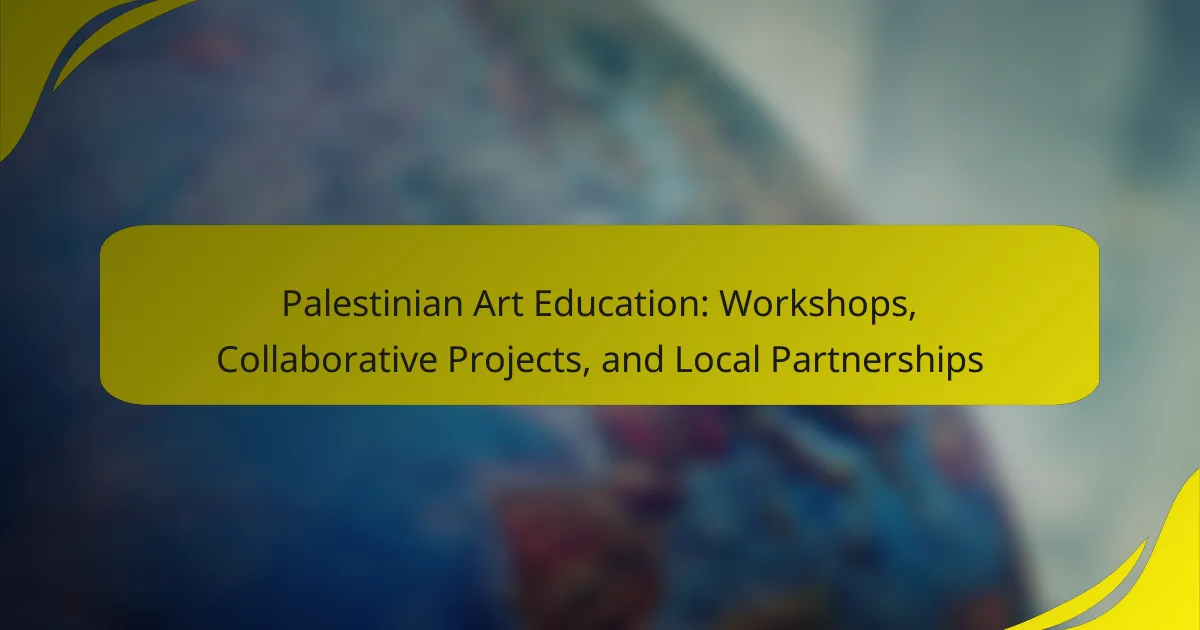Palestinian Art Education focuses on teaching artistic practices within the Palestinian context, emphasizing creativity and cultural expression among students. The curriculum is developed collaboratively by educators, artists, and cultural institutions, integrating local history, identity, and social issues while balancing technical skills with creative expression. Despite its potential to enhance community resilience and cultural preservation, Palestinian Art Education faces challenges such as limited resources, political instability, censorship, and a lack of trained educators. This article explores the methods of engagement, curriculum development, and student outcomes within this vital educational field.
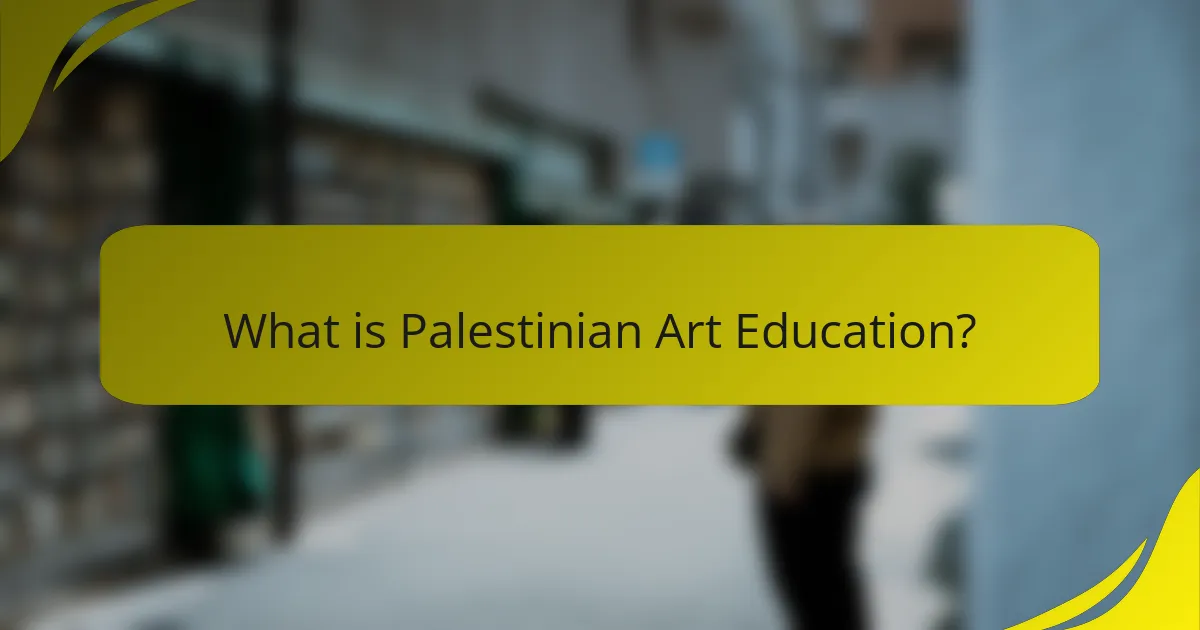
What is Palestinian Art Education?
Palestinian Art Education is a field focused on teaching artistic practices within the Palestinian context. It encompasses various methods of engagement, curriculum development, and student outcomes. This educational approach aims to foster creativity and cultural expression among Palestinian students. It often integrates local history, identity, and social issues into the curriculum. Programs may include visual arts, music, and performing arts. Palestinian Art Education seeks to empower students through self-expression and critical thinking. Research shows that such education can enhance community resilience and cultural preservation. The emphasis is on nurturing a distinct Palestinian artistic voice.
How is Palestinian Art Education defined within the cultural context?
Palestinian Art Education is defined as a means of cultural expression and identity formation within the Palestinian community. It emphasizes the historical and social narratives of Palestine through various artistic mediums. This educational approach integrates traditional and contemporary art forms, reflecting the unique experiences of Palestinians. Art education in this context serves as a tool for resistance and empowerment. It fosters critical thinking and creativity among students. Additionally, it aims to preserve cultural heritage while addressing current socio-political issues. The curriculum often includes local artists and cultural practitioners, enhancing relevance and engagement. This holistic approach is essential for nurturing a sense of belonging and community among students.
What historical influences shape Palestinian Art Education?
Palestinian Art Education is shaped by several historical influences. The impact of the Israeli-Palestinian conflict is significant. This conflict has affected access to resources and opportunities for artistic expression. Additionally, the cultural heritage of Palestine plays a crucial role. Traditional art forms and folk practices inform contemporary educational approaches.
The influence of global art movements also contributes to the curriculum. Palestinian artists engage with international trends while maintaining local relevance. Furthermore, the role of diaspora communities is notable. They often support art education through funding and cultural exchange.
Finally, the political landscape influences the themes explored in Palestinian art. Issues of identity, resistance, and heritage are prevalent in educational settings. These historical influences collectively shape the framework of Palestinian Art Education today.
What are the key objectives of Palestinian Art Education?
The key objectives of Palestinian Art Education include fostering cultural identity and promoting self-expression. This educational approach aims to empower students through creative skills. It encourages critical thinking and enhances visual literacy. Palestinian Art Education seeks to preserve and promote Palestinian heritage. It also facilitates dialogue about social and political issues through artistic expression. Furthermore, it aims to develop community engagement and collaboration among students. These objectives are essential for nurturing a generation that values its cultural roots and contributes to society.
What are the primary methods of engagement in Palestinian Art Education?
The primary methods of engagement in Palestinian Art Education include community workshops, collaborative projects, and digital platforms. Community workshops foster local participation and cultural expression. They often involve artists and educators working together to create art that reflects Palestinian identity. Collaborative projects encourage teamwork among students, promoting peer learning and shared creativity. Digital platforms expand access to art education, allowing students to engage with global art communities. These methods enhance the learning experience by integrating cultural relevance and fostering a sense of belonging.
How do educators incorporate traditional art forms in their teaching?
Educators incorporate traditional art forms in their teaching by integrating them into lesson plans and activities. They use local art techniques to connect students with their cultural heritage. Workshops and hands-on activities allow students to create art using traditional methods. This approach fosters creativity and enhances cultural awareness. Studies show that students engaged in traditional art forms demonstrate improved critical thinking skills. Additionally, these practices promote community involvement and collaboration among students. By showcasing local artists, educators inspire students to appreciate their cultural identity. Overall, traditional art forms enrich the educational experience and strengthen cultural ties.
What role do community involvement and collaboration play in engagement?
Community involvement and collaboration are crucial for engagement in Palestinian art education. They foster a sense of belonging among students and the community. Collaborative projects enhance creativity and provide diverse perspectives. Engagement increases when community members participate in educational activities. Studies show that active community involvement boosts student motivation and learning outcomes. For example, programs that integrate local artists into the curriculum have proven to improve student interest and skills. Therefore, community collaboration enriches the educational experience and strengthens ties between students and their cultural heritage.
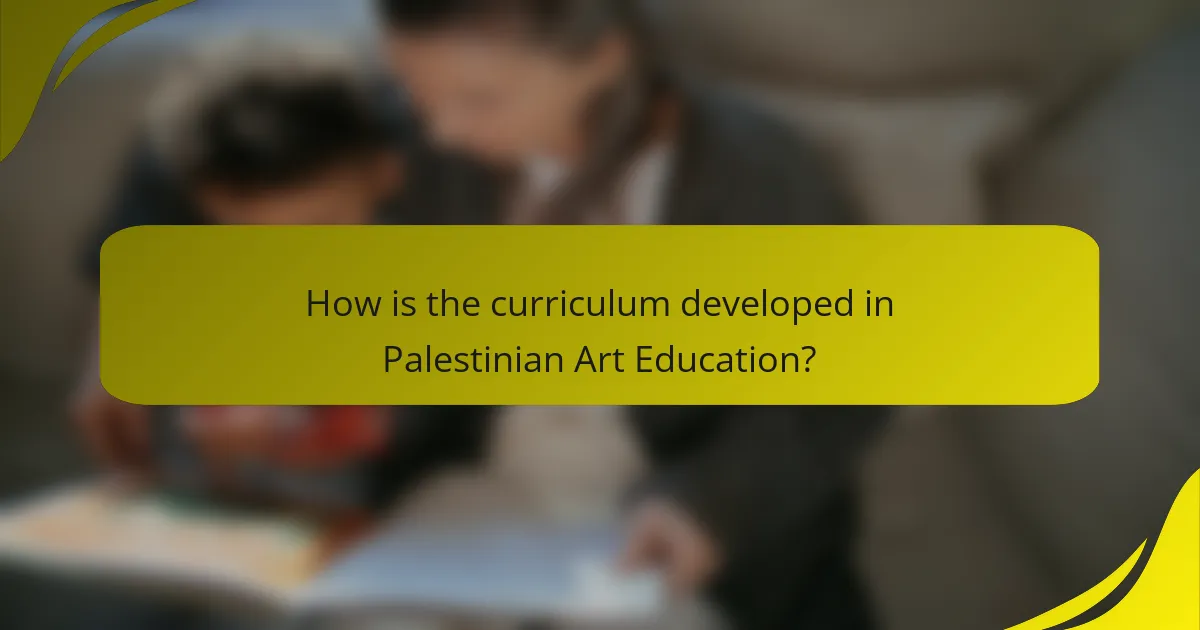
How is the curriculum developed in Palestinian Art Education?
The curriculum in Palestinian Art Education is developed through a collaborative process involving educators, artists, and cultural institutions. This approach ensures that the curriculum reflects local cultural contexts and artistic traditions. Input from various stakeholders is gathered to create a well-rounded educational framework. The curriculum emphasizes both technical skills and creative expression. It incorporates contemporary art practices alongside traditional techniques. Regular assessments and feedback from students inform ongoing curriculum adjustments. Additionally, community engagement plays a crucial role in shaping relevant content. This collaborative and adaptive methodology aims to foster artistic growth and cultural identity among students.
What are the foundational elements of the curriculum?
The foundational elements of the curriculum include goals, content, pedagogy, assessment, and context. Goals define the intended outcomes of the educational process. Content encompasses the subjects and materials taught. Pedagogy refers to the methods and strategies used for instruction. Assessment evaluates student learning and curriculum effectiveness. Context involves the cultural, social, and political environment influencing the curriculum. Each of these elements is crucial for creating a comprehensive and effective curriculum in Palestinian art education.
How do cultural narratives influence curriculum content?
Cultural narratives shape curriculum content by embedding values, beliefs, and historical context into educational materials. These narratives influence what is taught and how it is presented. For instance, in Palestinian art education, cultural narratives emphasize identity and heritage. This focus encourages students to explore their cultural roots through artistic expression. Research shows that curricula reflecting students’ cultural backgrounds enhance engagement and learning outcomes. According to a study by Al-Hassan (2020), culturally relevant pedagogy fosters a sense of belonging among Palestinian students. This connection to cultural narratives ultimately enriches the educational experience and promotes critical thinking.
What types of artistic disciplines are included in the curriculum?
The curriculum includes various artistic disciplines such as visual arts, music, theater, and dance. Visual arts encompass painting, sculpture, and photography. Music education covers instrumental and vocal training. Theater focuses on acting, directing, and playwriting. Dance incorporates various styles and techniques. These disciplines aim to foster creativity and cultural expression in students. They also enhance critical thinking and collaboration skills.
How do educators assess student outcomes in Palestinian Art Education?
Educators assess student outcomes in Palestinian Art Education through various methods. They utilize formative assessments to monitor student progress during the learning process. Summative assessments are also employed to evaluate overall student achievement at the end of a unit. Educators often incorporate portfolios to showcase students’ artistic development and individual expression. Peer assessments encourage collaboration and critical feedback among students. Rubrics are used to provide clear criteria for evaluating artistic work. Additionally, educators may conduct observational assessments to gauge student engagement and participation in art activities. These assessment methods ensure a comprehensive understanding of student learning and artistic growth.
What metrics are used to evaluate student artistic development?
Metrics used to evaluate student artistic development include portfolio assessments, self-reflections, and peer critiques. Portfolio assessments provide a comprehensive view of a student’s work over time. They showcase growth in skills and creativity. Self-reflections encourage students to articulate their artistic process and personal growth. Peer critiques foster collaborative learning and provide diverse perspectives on artistic work. Additionally, teacher assessments evaluate technical skills and conceptual understanding. These metrics collectively offer a holistic approach to measuring artistic development in students.
How do student outcomes reflect broader societal impacts?
Student outcomes reflect broader societal impacts by indicating the effectiveness of educational systems in addressing community needs. High student achievement often correlates with improved economic conditions and social stability. For instance, studies show that better educational outcomes lead to higher employment rates and reduced poverty levels. In the context of Palestinian art education, successful student projects can foster cultural identity and social cohesion. Additionally, when students engage in art, they may become advocates for social change, influencing community perspectives. Therefore, monitoring student outcomes provides insights into the overall health and progress of society.
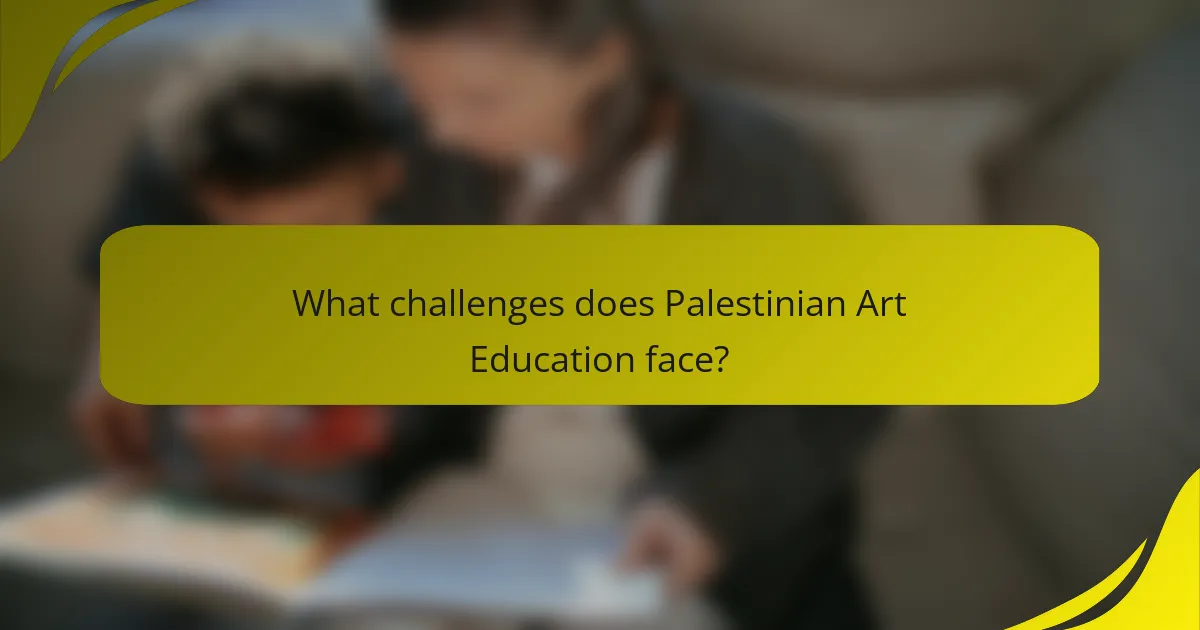
What challenges does Palestinian Art Education face?
Palestinian art education faces significant challenges. Limited resources hinder access to materials and facilities. Political instability affects the overall educational environment. Censorship restricts creative expression and curriculum content. Socio-economic factors limit student participation in art programs. Additionally, a lack of trained educators impacts the quality of instruction. Cultural and historical contexts complicate the integration of contemporary art practices. These factors collectively undermine the effectiveness of art education in Palestine.
What barriers exist in the implementation of art education programs?
Barriers in the implementation of art education programs include limited funding and resources. Many schools lack the budget to hire qualified art teachers. Additionally, inadequate facilities hinder the delivery of effective art education. Cultural perceptions often undervalue the importance of art in education. Political instability can disrupt educational initiatives and resource allocation. Furthermore, curriculum restrictions limit the inclusion of creative subjects. Lastly, lack of community support can impede program sustainability. These factors collectively challenge the successful integration of art education in Palestinian contexts.
How do political and social factors affect art education accessibility?
Political and social factors significantly affect art education accessibility. In regions like Palestine, political instability can lead to restricted funding for educational programs. This results in limited resources for art supplies and qualified instructors. Social factors, such as cultural attitudes towards art, can also impact participation rates. Communities that prioritize traditional education may undervalue art, reducing student engagement. Additionally, social inequality can create barriers for marginalized groups, limiting their access to art education. Research indicates that areas with conflict often see a decline in educational opportunities, including the arts. For instance, UNESCO reports that conflict zones experience substantial disruptions in educational services.
What innovative practices are emerging in Palestinian Art Education?
Innovative practices emerging in Palestinian Art Education include community-based art projects and digital storytelling. These practices foster collaboration among students, artists, and local communities. Community-based projects often involve creating murals or installations that reflect social issues. Digital storytelling allows students to express their narratives through multimedia platforms.
Additionally, art education is increasingly integrating technology, such as virtual reality and online workshops. These tools enhance accessibility and engagement for students. Collaborative platforms also enable cross-cultural exchanges with international artists.
Research indicates that these practices improve critical thinking and creativity among students. They provide a platform for dialogue and cultural expression. Overall, these innovative methods are reshaping the landscape of art education in Palestine.
How are digital tools transforming art education in Palestine?
Digital tools are significantly transforming art education in Palestine by enhancing accessibility and engagement. These tools include online platforms, digital art software, and virtual classrooms. They allow students to access a wider range of resources and tutorials. This shift supports diverse learning styles and fosters creativity.
Moreover, digital tools enable collaboration among students and teachers across different locations. Programs like Google Classroom facilitate communication and feedback. This connectivity helps build a supportive learning community.
Research indicates that integrating technology in education leads to improved student outcomes. A study by the Palestinian Ministry of Education found that digital tools increased student participation in art projects. This transformation is crucial for developing artistic skills and cultural expression in Palestine.
What role do international collaborations play in enhancing art education?
International collaborations significantly enhance art education by providing diverse perspectives and resources. They facilitate knowledge exchange between institutions across different countries. This exchange allows educators to adopt innovative teaching methods. Collaborative projects often lead to joint exhibitions and workshops, enriching students’ experiences. Furthermore, partnerships with international artists expose students to global art trends. Such interactions can inspire creativity and broaden artistic horizons. Research shows that students involved in international collaborations demonstrate improved critical thinking skills. They also gain a deeper understanding of cultural contexts in art.
What best practices can enhance Palestinian Art Education?
Integrating community involvement is a best practice that can enhance Palestinian Art Education. Engaging local artists and cultural organizations fosters a sense of ownership among students. Collaborative projects can provide real-world experience and relevance to the curriculum.
Incorporating diverse artistic mediums is also crucial. This approach allows students to explore various forms of expression. Access to different materials can ignite creativity and innovation.
Implementing culturally relevant content enriches the learning experience. Teaching about Palestinian heritage through art can strengthen identity and pride. This relevance can increase student engagement and motivation.
Professional development for educators is essential. Training programs can equip teachers with modern pedagogical strategies. Continuous learning ensures that educators remain effective in their teaching methods.
Assessment methods should be varied and holistic. Incorporating self-assessment and peer feedback encourages reflection. This practice can lead to a deeper understanding of artistic growth.
Finally, fostering a supportive environment is vital. Creating safe spaces for expression allows students to take creative risks. A nurturing atmosphere can significantly improve student outcomes in art education.
How can educators effectively integrate local culture into their teaching?
Educators can effectively integrate local culture into their teaching by incorporating culturally relevant materials and examples. This approach engages students and makes learning more relatable. For instance, art lessons can include local Palestinian artists and their works. This not only highlights local talent but also fosters a sense of identity. Additionally, educators can encourage students to explore local history and traditions through projects. By doing so, they create a meaningful context for learning. Research shows that culturally responsive teaching improves student engagement and academic outcomes. A study found that students perform better when their cultural backgrounds are acknowledged in the curriculum. This method enriches the educational experience and strengthens community ties.
What strategies can be employed to foster creativity and critical thinking in students?
Employing project-based learning fosters creativity and critical thinking in students. This strategy encourages students to engage in real-world problems. They collaborate to create solutions, enhancing their analytical skills. Incorporating open-ended questions stimulates student inquiry and exploration. Students learn to evaluate multiple perspectives through discussions. Integrating technology in art education promotes innovative thinking. Digital tools allow for diverse forms of expression. Providing constructive feedback helps students refine their ideas. This process develops their ability to critique and improve their work. These strategies align with educational research emphasizing active learning’s role in creative development.
Palestinian Art Education is a specialized field that focuses on teaching artistic practices within the Palestinian context, emphasizing cultural identity and self-expression. The article explores various methods of engagement, such as community workshops and digital platforms, and details the curriculum development that incorporates local history, traditional art forms, and contemporary practices. It also highlights the key objectives of fostering creativity, critical thinking, and cultural preservation among students, while addressing the challenges faced in implementation due to political and social factors. Additionally, the article examines innovative practices and best strategies to enhance art education, ensuring a comprehensive understanding of the impact on student outcomes and community resilience.
